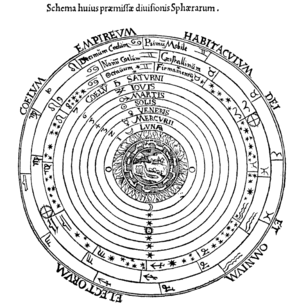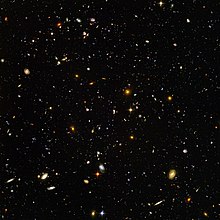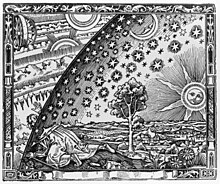Cosmos: Difference between revisions
No edit summary |
|||
| Line 55: | Line 55: | ||
[[Space]] is a fabric that can bend, twist and is the fabric of the cosmos. With [[Time|time]] it forms a 4 dimensional fabric named . The fact the [[Speed of light|speed of light]] which is the space traveled by light is the same for everyone whether moving or not shows that space-time adjust itself so light seems to travel at the same speed no matter what. |
[[Space]] is a fabric that can bend, twist and is the fabric of the cosmos. With [[Time|time]] it forms a 4 dimensional fabric named . The fact the [[Speed of light|speed of light]] which is the space traveled by light is the same for everyone whether moving or not shows that space-time adjust itself so light seems to travel at the same speed no matter what. |
||
Remember that space is a flexible fabric that contains the galaxies which are made of stars, planets that are very heavy objects. Their weight |
Remember that space is a flexible fabric that contains the galaxies which are made of stars, planets that are very heavy objects. Their weight bends the fabric of space time which creates a curvature that makes it possible for lighter objects to go around heavier objects as is the case for the planet earth and the lighter weight moon; and also the planets and the sun in our galaxy. This phenomena is known as [[Gravity|gravity]] which is one of the four forces of the cosmos. |
||
| Line 62: | Line 62: | ||
Since space and time are unified the motion through space impacts time: time |
Since space and time are unified, the motion through space impacts time: time slows down for the person who is moving but goes faster for the one who stands still; which implies that the passage of time as we experience it may be just an illusion. In that case, every moment in time from the beginning till far in the future coexists together; but in a different region of the cosmos. That leads to the concept of time travel: due to the fact that space and time are a unified physical entity it is possible that there are some shortcuts in the fabric of space time that can lead us to another period of time different from our present time. Despite the possibility of time travel; there is no proof that we can change the past or even the future. The reason: the different periods of time coexist and have a fixed state. Still, the exact nature of time is not fully understood. |
||
| Line 105: | Line 105: | ||
Ordered system of all that exist from outer space down to the atomic scale. |
Ordered system of all that exist from outer space down to the atomic scale. |
||
== See also == |
== See also == |
||
Revision as of 15:49, 19 December 2012
This article includes a list of general references, but it lacks sufficient corresponding inline citations. (April 2009) |

In the general sense, a cosmos is an orderly or harmonious system. It originates from the Greek term κόσμος (kosmos), meaning "order" or "ornament"[1] and is antithetical to the concept of chaos. Today, the word is generally used as a synonym of the Latin loanword "Universe" (considered in its orderly aspect). The word cosmetics originates from the same root. In many Slavic languages such as Russian, Bulgarian, and Serbian, the word Космос cosmos means also the "outer space". In Mandarin Chinese, cosmos and universe are both translated as 宇宙 yǔzhòu, which literally translated means space-time (宇 yǔ = space + 宙 zhòu = time).
Philosophy

Pythagoras is said to have been the first philosopher to apply the term cosmos to the Universe, perhaps referring to the starry firmament.
Russian cosmism is a cosmocentric philosophical and cultural movement that emerged in Russia in the early 20th century.
Cosmicism is a philosophical position that mankind is an insignificant aspect of a universe at best indifferent and perhaps hostile. This philosophy, explored by writers such as H.P. Lovecraft (who some say is the original proponent of the philosophy) and later writers who actually represented the beliefs in books such as Hitchhiker's Guide to the Galaxy.
Theology
In theology, the term can be used to denote the created Universe, not including the creator. In Christian theology, the word was also used synonymously with aion to refer to "worldly life" or "this world" as opposed to the afterlife or World to Come.
The cosmos as originated by Pythagoras is parallel to the Zoroastrian term aša, the concept of a divine order, or divinely ordered creation.
Cosmology

Cosmology is the study of the cosmos in several of the above meanings, depending on context. All cosmologies have in common an attempt to understand the implicit order within the whole of being. In this way, most religions and philosophical systems have a cosmology.

In physical cosmology, the term cosmos is often used in a technical way, referring to a particular space-time continuum within the (postulated) multiverse. Our particular cosmos is generally capitalized as the Cosmos.
Integral Philosophy
The philosopher Ken Wilber uses the term kosmos to refer to all of manifest existence, including various realms of consciousness. The term kosmos so used distinguishes a nondual Universe (which, in his view, includes both noetic and physical aspects) from the strictly physical Universe that is the concern of the traditional sciences. Wilber's nephew (Cosmo Iacavazzi, fullback at Princeton University) is said to have been named after the scientific term.
Ancient Greek conception of the cosmos
The Ancient Greek natural philosopher Archimedes in his essay The Sand Reckoner, estimated the diameter of the cosmos to be the equivalent in stadia of what we call two light years.
Age and size of the cosmos
According to current scientific theory, the cosmos began 13.7 billion years ago short scale in the Big Bang. The current diameter of the observable cosmos is thought to be about 93 billion light years.
The diameter of the entire cosmos is unknown. However, according to Alan Guth's inflation theory, the actual size of the cosmos is at least fifteen orders of magnitude larger than the observable universe. This means that if the inflation theory is correct, the 93 billion light year diameter of the observable universe is approximately as much smaller than the diameter of the entire universe as the diameter of a helium atom is compared to the diameter of the Sun. This is equivalent to a minimum diameter of the entire cosmos of 1026 light years (100 septillion light years short scale).
The Nature of the Cosmos
Space
Space is a fabric that can bend, twist and is the fabric of the cosmos. With time it forms a 4 dimensional fabric named . The fact the speed of light which is the space traveled by light is the same for everyone whether moving or not shows that space-time adjust itself so light seems to travel at the same speed no matter what. Remember that space is a flexible fabric that contains the galaxies which are made of stars, planets that are very heavy objects. Their weight bends the fabric of space time which creates a curvature that makes it possible for lighter objects to go around heavier objects as is the case for the planet earth and the lighter weight moon; and also the planets and the sun in our galaxy. This phenomena is known as gravity which is one of the four forces of the cosmos.
Time
Since space and time are unified, the motion through space impacts time: time slows down for the person who is moving but goes faster for the one who stands still; which implies that the passage of time as we experience it may be just an illusion. In that case, every moment in time from the beginning till far in the future coexists together; but in a different region of the cosmos. That leads to the concept of time travel: due to the fact that space and time are a unified physical entity it is possible that there are some shortcuts in the fabric of space time that can lead us to another period of time different from our present time. Despite the possibility of time travel; there is no proof that we can change the past or even the future. The reason: the different periods of time coexist and have a fixed state. Still, the exact nature of time is not fully understood.
Forces of the Cosmos
•General relativity: Einstein's theory of gravity; invoke curvature of space and time.[2]
•Electromagnetic force: One of nature's forces; acts on particles that have electric charge.[3]
•Strong nuclear force: Force of nature that influences quarks; holds quarks together inside protons and neutrons.[4]
•Weak nuclear force: 'Force of Nature, acting on subatomic scales, and responsible for phenomena such as radioactive decay'.[5]
The last 3 forces exist at quantum level which is the atomic scale. The problem is that gravity is the force that happens at the astronomic level and atoms at the quantum level behave differently from the general relativity. With gravity, the nature of the cosmos is very predictable and ordered, however at the quantum level, the particle energy and position are unpredictable. For physicists, it is hard to fit order into the chaos that is happening at atomic level. At the quantum level, gravity force can be explained by the presence of a particle named graviton. This is a particle of energy released by the effect of gravity on the fabric of space-time. The only issue, no experiment has yet proved the existence of such particle. At the surface space is flexible, ordered but at quantum level it is active, unpredictable, and multidimensional.
The quest for unification
The goal is to combine all the laws in physics into one that can explain the whole cosmos from the outer space down to the quantum scale. Today, there is a popular theory named String theory that provides an explanation of the fundamental nature of the Cosmos.
SuperString Theory or String theory:Theory in which fundamental ingredients are one-dimensional loops(closed strings)or snippets(open strings), of vibrating energy, which units general relativity and quantum mechanics.[6]
The fact that the particles behave like wave suggests that they are made of strand shaped like string at the most fundamental level. The shape of the energy strand determines what is a proton is and what is a neutron. In other words different shapes produce different particles. So far, it is just a theory because no scientific experiment supports or disproves the string theory.
Cosmos Defintion
Taking the nature of the cosmos in consideration, it can be defined as followed:
Ordered system of all that exist from outer space down to the atomic scale.
See also
- Anthropic principle
- Astronomy
- Cosmic Logos
- Cosmic View
- Cosmic Zoom
- Cosmology
- Cosmogram
- Cosmography
- Cosmos: A Personal Voyage (Carl Sagan's television documentary series)
- Fate of the universe
- Lambda-CDM model
- Large scale structure of the cosmos
- Macrocosm and microcosm
- Megaverse
- Multiverse
- Observable universe
- Omega point (de Chardin)
- Omega point (Tipler)
- Omniverse
- Timeline of the Big Bang
References
- ^ κόσμος, Henry George Liddell, Robert Scott, A Greek-English Lexicon, on Perseus
- ^ Brian, Greene. The Fabric of the Cosmos: Space, Time, and the Texture of Reality. Vintage Books, 2004, p. 538.
- ^ Brian, Greene. The Fabric of the Cosmos: Space, Time, and the Texture of Reality. Vintage Books, 2004, p. 538.
- ^ Brian, Greene. The Fabric of the Cosmos: Space, Time, and the Texture of Reality. Vintage Books, 2004, p. 540.
- ^ Brian, Greene. The Fabric of the Cosmos: Space, Time, and the Texture of Reality. Vintage Books, 2004, p. 540.
- ^ Brian, Greene. The Fabric of the Cosmos: Space, Time, and the Texture of Reality. Vintage Books, 2004, p. 540.
External links
- Cosmos – an Illustrated Dimensional Journey from microcosmos to macrocosmos – from Digital Nature Agency
- JPL Spitzer telescope photos of macrocosmos
- Macrocosm and Microcosm, in Dictionary of the History of Ideas
- Encyclopedia of Cosmos This is in Japanese.
- merriam-webster.com/dictionary/cosmic
- CosmosTemplate:Ref-ru Illustrated Encyclopedia of Cosmos and Cosmic Law
- Greene, B. (1999). The Elegant Universe: Superstrings, Hidden Dimensions, and the Quest for the Ultimate Theory. W.W. Norton, New York
- Hawking, S. W. (2001). The Universe in a Nutshell. Bantam Book.
- Yulsman, T. (2003). Origins: The Quest for our Cosmic Roots. Institute of Physics Publishing, London.
